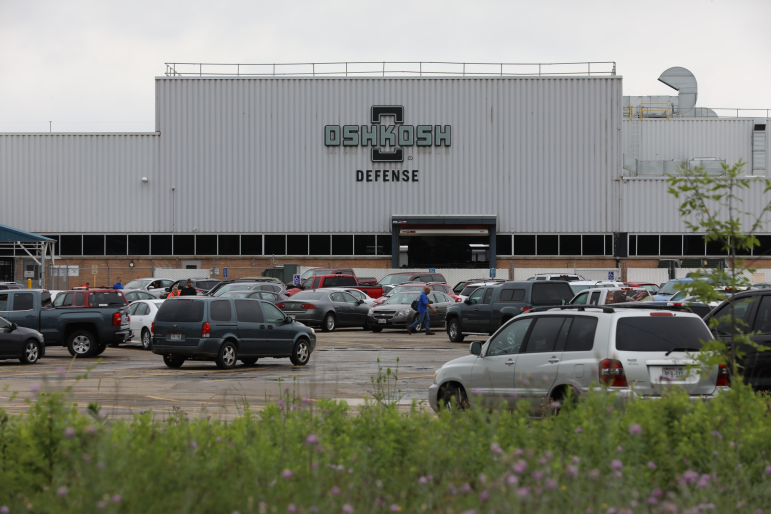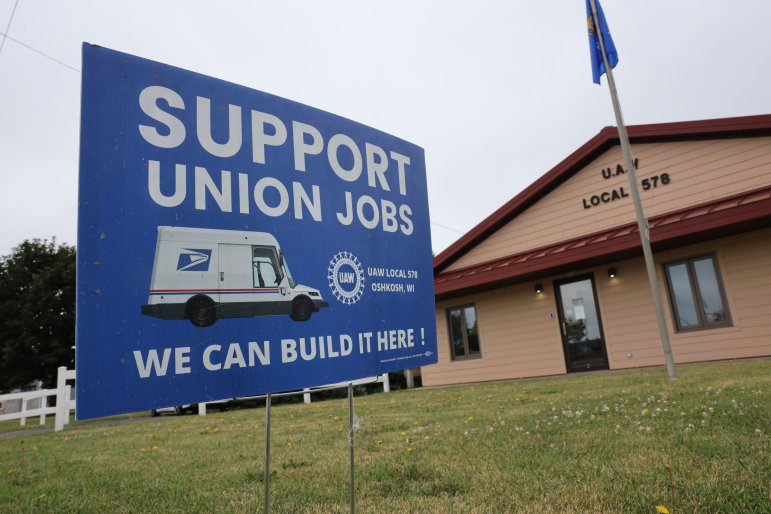Oshkosh Defense sent a big contract to the non-union South. Will it keep future jobs in Wisconsin?

The news in early 2021 that Oshkosh Corp.’s defense subsidiary had secured a multi-billion dollar federal contract to build up to 165,000 postal trucks elicited a mix of pride and relief among Oshkosh, Wisconsin residents.
Since the end of the wars in Iraq and Afghanistan, the the Pentagon has ordered fewer tactical vehicles, and employment has dropped at the corporation’s Oshkosh assembly plants
So the 2021 announcement allowed the military contractor to tout a swords-into-plowshares pivot that would support at least a thousand more middle-class jobs for Wisconsinites, keeping the region’s manufacturing humming for another decade.

But the euphoria lasted barely four months. By June 2021, Oshkosh Defense announced it would not build tens of thousands of postal trucks in its existing Oshkosh assembly lines but shift production to a $155 million plant out of state. Instead of getting 1,000 new assembly workers, Wisconsin now stands to add around 100 design and administration jobs under the contract.
“I was really very proud that they won that postal contract,” Oshkosh Mayor Lori Palmeri said. “So then it was kind of a little bit of a whiplash when the announcement was made that it was going to South Carolina.”
Rather than build in its namesake city, the company will assemble next-generation postal vehicles about 900 miles away in Spartanburg, South Carolina at a 97-acre industrial site of a shuttered RiteAid distribution center.
Oshkosh Corp.’s decision to make postal trucks in South Carolina has opened debate over how much loyalty a corporation owes to a community and state that have extended more than $70 million in tax credits and other incentives.

Lawsuits challenge contract
The plan to build the postal trucks in South Carolina is being challenged in federal court by three lawsuits filed on April 28 — one brought by an unlikely alliance of environmentalists and organized labor and another by two environmental groups. And the third complaint — amended in June — was filed by 17 states, the District of Columbia, New York City and the air-quality board covering the San Francisco Bay Area. The Postal Service has moved for those cases to be combined and litigated in a D.C. courtroom.
Both lawsuits claim the Postal Service violated the National Environmental Policy Act by choosing inefficient gas-powered vehicles to replace its fleet. Production is scheduled to begin in 2023.
The pressure may be working. Last month, the Postal Service announced that at least half of the new vehicles would be electric. It also limited its commitment to Oshkosh Defense to the initial $2.98 billion order for 50,000 postal trucks.
In a July 28 call with investors, Oshkosh Corp. CEO John Pfeifer rejected any suggestion that the postal service was backpedaling on the deal or that his company could not produce enough battery electric vehicles.
“Everything that’s happening with the U.S. Postal Service is positive for us,” he told investors. “If USPS wants to go to 100% (electric), we can go to 100%.”
Pfeifer also told investors that the Postal Service’s sudden announcement that it plans to replace some of its fleet with at least 34,500 commercially available “off the shelf” vehicles from other vendors would not hurt the company’s bottom line. But it does raise questions about just how many vehicles the Spartanburg plant will ultimately produce for the Postal Service.

The USPS announcement won plaudits from environmentalists — but labor leaders want more.
“Our position has always been: We want Oshkosh (Defense) to get the electric vehicle work,” UAW’s national vice president Cindy Estrada told Wisconsin Watch. “But we also want them to do it under a union contract where there’s democracy in the workforce.”
Officials and workers are now eyeing another huge federal contract to be awarded by early 2023 that could either boost Oshkosh Corp.’s in-state manufacturing — or send even more jobs out of state. An Oshkosh Defense official told Wisconsin Watch the company is “laser-focused” on keeping that work in Wisconsin.

More than $70 million in tax subsidies
This is not the first time in recent history that Oshkosh Corp. has threatened to step away from the city where it has been rooted for more than a century. In 2017, company officials aimed to move the corporate headquarters out of town — a plan that was thwarted only after Oshkosh city officials agreed to sell the company prime public land on Lake Butte des Morts and offer significant tax incentives.
That large companies play governments against each other is not new. But looking closer, Oshkosh Defense’s postal contract is arguably not a matter where one community wins and another loses.
South Carolina’s incentives include a $9 million grant, plus a locally-approved 40-year property tax break. Elected officials in Wisconsin have been careful not to directly criticize the company.
“My fear is that we try to stop this — hold it up — and at the end of the day, we lose the contract entirely,” Winnebago County Executive Jon Doemel said.
Lack of capacity cited for move
Oshkosh Defense says it had considered several sites around the country to build postal trucks — including in Wisconsin — but struggled to find existing buildings with the needed 825,000 square feet of capacity.
“Wisconsin simply did not have any available buildings that could meet this requirement,” Oshkosh Defense spokesperson Alexandra Hittle told Wisconsin Watch in an email.
Union members in Oshkosh doubt that claim, with some calling it a potential attempt to weaken the local United Auto Workers union, which has represented assembly workers since 1938.
UAW Local 578 President Bob Lynk questioned why the company’s $155 million investment on a new plant in South Carolina pencils out unless it sees savings on labor costs.
There’s been no official word on wage scale in Spartanburg. But an online marketplace has begun advertising Spartanburg County-based management positions in engineering, accounting and logistics that require a college degree starting at $8.30 an hour. According to a redacted copy of the 73-page postal truck contract obtained by Wisconsin Watch, the only provision relating to pay is a requirement to offer at least the federal minimum wage of $7.25 an hour.
In Oshkosh, union members start at $15.99 an hour, and no college degree is required.
Union jobs going away
Wisconsin’s elected leaders say the lure of cheaper labor and generous subsidies are eroding the region’s manufacturing base.
“This isn’t the first time South Carolina, and that part of the country has thrown incentives, with no accountability, trying to poach existing businesses,” said Assembly Minority Leader Rep. Gordon Hintz, D-Oshkosh, and a member of the Wisconsin Economic Development Corp. board of directors.
Oshkosh Defense has been sending jobs to non-union states for several years. The company outsourced up to 300 assembly jobs to a non-union plant in Jefferson City, Tennessee, in 2019.
In Oshkosh, production on military vehicles has slowed, with about 1,500 UAW members currently working in Oshkosh plants. That’s about half the unionized workforce from 2008, when the company’s stock plummeted, suffering a “near-death” experience, said defense analyst Loren B. Thompson of the Lexington Institute, a think tank funded by defense contractors including Oshkosh.
Oshkosh Defense was saved, Thompson said, by a series of U.S. Army contracts for armored vehicles. State and local governments helped secure the work by subsidizing an electropainting processing facility. The contract to build the Family of Medium Tactical Vehicles, worth more than $3 billion, created about 2,000 jobs in Oshkosh.
The state of Wisconsin initially paid for about two-thirds of the $51.5 million cost of the e-painting facility through tax credits. And the city of Oshkosh borrowed $5 million to finance the project at a cost to taxpayers of around $8 million.
Over time, WEDC’S investment in Oshkosh Corp. grew to $55 million in state tax credits in exchange for at least 1,000 jobs paying a minimum $25 an hour. Hittle noted the company had “met all commitments related to any applicable incentives.”
‘We weren’t even a contender’
In 2017, the company notified the city that it needed a new headquarters and was looking at sites out of town. Soon after, a deal had crystallized to sell the company prime parkland, including a golf course, for the headquarters.
“The way it was explained, we weren’t even a contender until, you know, we kind of scrambled and looked at that (site) as a potential,” recalled Palmeri, who was a council member at the time. Public opinion was divided over closing the golf course, but the council ultimately approved the deal in a unanimous 6-0 vote.
Oshkosh Corp. paid the city $3.5 million for a 32-acre portion of the now-closed public golf course. The city paid more than $7.2 million to extend roads, utilities and other infrastructure and a $6 million tax incentive payable over 12 years for the glass-and-steel headquarters dubbed “Glass Palace.” The rest of the municipal golf course was converted into a city park, which mollified some of the deal’s critics.
WEDC provided a further $8 million in state tax credits to keep the headquarters’ 450 employees in Oshkosh. Then-Gov. Scott Walker thanked Oshkosh Corp. “for its ongoing commitment to Wisconsin.”
But three years later, that commitment did not keep the company from being enticed by South Carolina, a state long known for its generous incentives for large corporate employers. Those types of tax breaks cost South Carolina schools $2.2 billion in property tax revenue between 2017 and 2021, according to an estimate by the nonprofit Good Jobs First.
Spartanburg County officials offered to slash property taxes by 40% over 40 years, adding $3 million to offset the property taxes. The company plans to create up to 1,078 jobs, but it will qualify for the property tax breaks by investing $150 million and keeping just 125 people on the payroll.
Next big contract looms
In Northeast Wisconsin, the focus has already shifted to the next big federal contract. Much of Oshkosh Corp.’s good fortune can be traced to the success of its Joint Light Tactical Vehicle — a truck it designed to largely replace the U.S. Army’s Humvee.
Even though Oshkosh Defense developed the vehicle and has been producing since winning the contract in 2015, the blueprints now belong to the Pentagon. The contract is being re-bid at the end of the year, and there’s fierce competition for the roughly $7.3 billion dollar prize to build 16,600 vehicles and 10,000 trailers.
“We will remain laser-focused on ensuring JLTVs under the follow-on contract are built right here in Oshkosh, Wisconsin,” Hittle told Wisconsin Watch.
If Oshkosh Defense does not win the contract, Lynk says 70% of his current members could be out of work. Which is why the effort to claw back the postal vehicle contract is so important.
“We supported Oshkosh (Corp.),” he said. “It's time for Oshkosh to do the right thing.”
This story is part of the NEW News Lab, a consortium of six news outlets covering northeastern Wisconsin. The nonprofit Wisconsin Watch collaborates with WPR and other news media and the University of Wisconsin-Madison School of Journalism and Mass Communication. All works created, published, posted or disseminated by Wisconsin Watch do not necessarily reflect the views or opinions of UW-Madison or any of its affiliates. This story is a collaboration between Wisconsin Watch and WPR as part of the NEW News Lab, a consortium of six news outlets covering northeastern Wisconsin.
This article originally appeared on Milwaukee Journal Sentinel: Oshkosh Defense sent work South. Will future jobs stay in Wisconsin?

